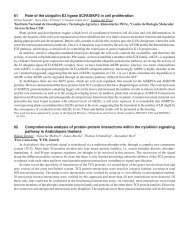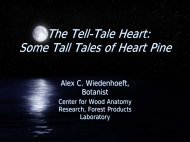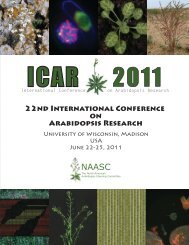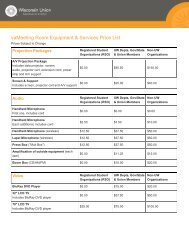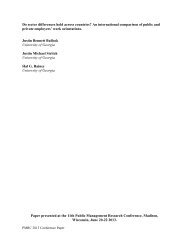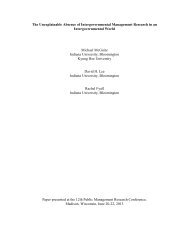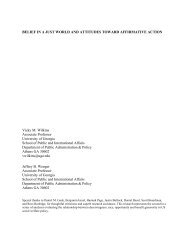PROGRAM & ABSTRACTS - Wisconsin Union - University of ...
PROGRAM & ABSTRACTS - Wisconsin Union - University of ...
PROGRAM & ABSTRACTS - Wisconsin Union - University of ...
Create successful ePaper yourself
Turn your PDF publications into a flip-book with our unique Google optimized e-Paper software.
Aging, Metabolism, Stress, Pathogenesis, and Small RNAs in C. elegans Topic Meeting 2012<br />
LC-MS Proteomics Analysis Reveals Both Common and Unique<br />
Changes in the Proteome <strong>of</strong> Insulin/IGF-1 Receptor Mutant and<br />
Dietary Restricted C. elegans<br />
Geert Depuydt1 , Fang Xie2 , Vladislav Petyuk2 , Heather Brewer2 , Arne Smolders1 , Ineke<br />
Dhondt1 , Nilesh Shanmugam1 , David Camp II2 , Richard Smith2 , Bart Braeckman2 1 2 Biology Department, Ghent <strong>University</strong>, B-9000 Ghent, Belgium, Biological<br />
Sciences Division and Environmental Molecular Sciences Laboratory, Pacific<br />
Northwest National Laboratory, Richland, WA 99352, USA<br />
Impaired insulin/IGF-1 signaling (IIS) and dietary restriction are two well-characterized<br />
lifespan extending interventions that operate by (partially) independent mechanisms in C.<br />
elegans. Taking advantage <strong>of</strong> recent developments in quantitative LC-MS/MS based proteomics,<br />
we sought to uncover potentially universal, as well as condition-specific, proteomic changes<br />
that could underlie daf-2(e1370)- and dietary restriction-induced longevity. A most striking<br />
pattern in the proteome fingerprints <strong>of</strong> both long-lived IIS-mutant and DR worms is the overall<br />
decrease in the abundance <strong>of</strong> a large number <strong>of</strong> ribosomal proteins <strong>of</strong> both the large (60S)<br />
and small (40S) subunits. Consistently, we found decreased rates <strong>of</strong> protein synthesis in our<br />
long-lived worms. These results indicate that a general downregulation in mRNA translation<br />
rate is part <strong>of</strong> an adaptive response that allows daf-2 and DR worms to be long-lived. A second<br />
common pattern in these worms is the increased abundance <strong>of</strong> many muscle proteins, which<br />
we could attribute to an increase in relative, but not absolute, muscle biomass. In addition,<br />
increased mRNA levels <strong>of</strong> muscle-related genes and higher concentrations <strong>of</strong> branched-chain<br />
amino acids as a result <strong>of</strong> their reduced catabolism in daf-2, suggest C. elegans attempts<br />
to preserve muscle integrity in conditions <strong>of</strong> low nutrient availability. A most striking pattern<br />
in the daf-2 proteome pr<strong>of</strong>ile is the strong upregulation <strong>of</strong> most core intermediary metabolic<br />
pathways (e.g. carbohydrate, fat, oxidative ATP generation), including several pathways that<br />
are reciprocally regulated. Despite this upregulation <strong>of</strong> the energy metabolic machinery, we<br />
found daf-2 animals fit a hypometabolic energy pr<strong>of</strong>ile, similar to dauers, but retain the ability<br />
for strong activity bursts when necessary.<br />
Contact: Geert.Depuydt@ugent.be<br />
Lab: Braeckman<br />
8<br />
Session 2



